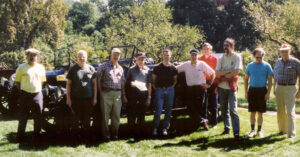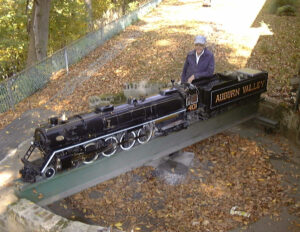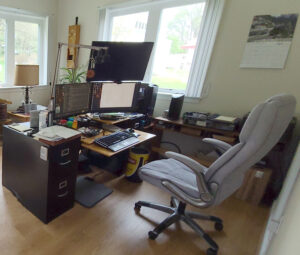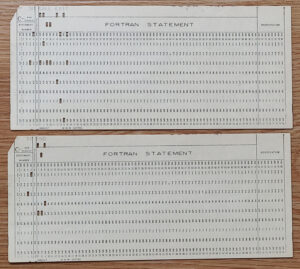CALL EXIT AND END
The closing question for 2024 is a simple one: “What might the future hold for preserving and sharing the many varied stories related to Auburn Heights, the Marshall family, and the greater Red Clay Creek Valley where Auburn Valley State Park resides? Who will make sure in the future that local history is researched and documented or that this column was preserved for future reference?” As a piece of added information, I shall share that I am retiring from writing the monthly Bob Wilhelm’s Question & Answer column, making this month’s article my last.
 In 1997 Tom Marshall gathered a group of individuals (photo left minus the author) interested in cars and steam power together under the notion that he wanted his father’s Stanley steam car collection preserved in a manner that ensured the collection might be enjoyed by future generations. Tom, a prolific communicator who enjoyed sharing his lifelong experiences, employed the then new technology of email to share his thoughts with more than a dozen individuals that became known as the Marshall Steam Team in Stanley steam car circles.
In 1997 Tom Marshall gathered a group of individuals (photo left minus the author) interested in cars and steam power together under the notion that he wanted his father’s Stanley steam car collection preserved in a manner that ensured the collection might be enjoyed by future generations. Tom, a prolific communicator who enjoyed sharing his lifelong experiences, employed the then new technology of email to share his thoughts with more than a dozen individuals that became known as the Marshall Steam Team in Stanley steam car circles.
This author relishes his distant memories as a charter member of the Marshall Steam Team of which 3 remain active. Tom’s weekly email communications highlighted the previous week’s two evening work session activities for those who could not attend, discussed ongoing plans, trips, and tours for our group, and always looked to the future by noting items needing attention as time, money, and volunteers became available. Tom’s emails were friendly, neighborly, and reminiscent of his evenings sitting in the machine shop’s desk chair while sharing experiences verbally. Tom eventually supplemented those emails with personal remembrances and historical information related to the Marshall family, the family’s varied business activities, and life in general around Yorklyn including the greater New Castle County. Tom’s EMAILS are archived on an FAH-supported website for future generations with an interest to explore (click “Emails” to view).
In late 2012, as visitors increasingly asked questions about vulcanized fiber, “the buildings the State bought,” what exactly is Auburn Heights Preserve, and the Marshall family’s genealogical history during public events, I offered to pen a Weekly Question and Answer column that Tom could include with his weekly email. These articles, I hoped, would keep my technical and scientific writing skills nimble. The first question and answer, issued Monday, November 26, 2012, discussed the Auburn Heights Historical District and the Garrett Snuff Mills Historic District listings by the National Register of Historical Places. A total of 328 weekly question-and-answer articles had been written when the series ended on Monday March 11, 2019, shortly after Tom’s passing.
Following Tom’s passing, the Weekly Question and Answer became a monthly series as part of the emailed Monthly News from the Marshall Steam Museum. As I have decided to retire, this farewell article shall be my final monthly Bob Wilhelm’s Question & Answer for the FAH Monthly News. The additional 68 monthly articles written since Tom’s passing bring the grand total to 396 articles. There have been a lot of volunteer hours expended by me, and others, supporting Tom’s vision of sharing the history and legacy of Auburn Heights and its surroundings as well as Marshall family history from the time of William Penn.
 While I have been the shepherd of the endeavor out of respect and appreciation for Tom and all that he unselfishly shared with the local community, my love of Auburn Heights and Marshall history, local Red Clay Valley history, and technical writing, it would be unfair not to acknowledge others. No one has supported me more than Elliott Warburton, who has provided much inspiration and provided well researched and publication-ready articles when I was unable. In a like manner, the supporting cast includes Tom and Ruth Marshall, Pat Thompson, Teresa Pierce, Dan Citron, Scott Palmer, Mark Lawlor, Bill Rule, Bill Schwoebel, Robert Hopkins, Harrison Warren, Rose Ann Hoover, and countless visitors who supported this effort over the past decade with ideas, information, imagery, research leads, proofreading, and other vitally needed support. As the Friends organization evolved with a website and the use of technology applications, it has been FAH’s Executive and Educational Directors who transform a submitted document and images into something professional looking yet easy to email and document on the FAH website.
While I have been the shepherd of the endeavor out of respect and appreciation for Tom and all that he unselfishly shared with the local community, my love of Auburn Heights and Marshall history, local Red Clay Valley history, and technical writing, it would be unfair not to acknowledge others. No one has supported me more than Elliott Warburton, who has provided much inspiration and provided well researched and publication-ready articles when I was unable. In a like manner, the supporting cast includes Tom and Ruth Marshall, Pat Thompson, Teresa Pierce, Dan Citron, Scott Palmer, Mark Lawlor, Bill Rule, Bill Schwoebel, Robert Hopkins, Harrison Warren, Rose Ann Hoover, and countless visitors who supported this effort over the past decade with ideas, information, imagery, research leads, proofreading, and other vitally needed support. As the Friends organization evolved with a website and the use of technology applications, it has been FAH’s Executive and Educational Directors who transform a submitted document and images into something professional looking yet easy to email and document on the FAH website.
Younger generations seem to have adopted the “if I can’t learn all I need to know in a 30-second video, I’m not interested” practice. While articles a decade ago frequently sparked follow-up discussions with volunteers and Steamin’ Day guests seeking additional information or sharing memories of similar information and experiences, since COVID, such interactions occur infrequently. As with all things in the universe, there is a beginning, and eventually an end. Writing is a passion of mine, as is local history. I am grateful that organizations exist where preserving history and sharing it in a meaningful way is a primary goal written into their non-profit charters.
I believe humanity should be guided about the future through remembering our past. I do feel it is time for me to move on. Like operating my Stanley steam car, composing the Question & Answer has been an enjoyable and rewarding ride, and I hope our readers have enjoyed traveling along as my passenger(s). While interesting initially, I feel the time has come to close the garage doors on Bob Wilhelm’s Question & Answer. New experiences and challenges perhaps await my discovery and the strokes of my fingers on a mechanical keyboard. Hopefully, in time, a younger generation with a passion and a knack for sharing history in an informative and interesting manner will continue where I have left off. There is new material being uncovered continually and we all make history daily.
As for the answer to this month’s question, I am afraid the reader, like I, will have to wait for future historians to reflect on the 21st century just as I have this past 12 years reflected on the 20th century. For those wondering what the title of this last Q&A has to do with this article’s content, please read the answer.
Answer
 I learned to type in middle school on an old Remington mechanical typewriter. Little did I realize how that class would go on to impact the rest of my life. While I have never used a typewriter for actual writing, my first computer from Radio Shack in 1980 (TRS-80 Color Computer) ran a word processing program that I wrote in a computer language called BASIC that relied on audio cassettes for storing the computer’s memory of text. The copy was printed out with a dot-matrix printer for sharing with the publisher, Hayden Books. The figures were generated using an early Intergraph CAD system.
I learned to type in middle school on an old Remington mechanical typewriter. Little did I realize how that class would go on to impact the rest of my life. While I have never used a typewriter for actual writing, my first computer from Radio Shack in 1980 (TRS-80 Color Computer) ran a word processing program that I wrote in a computer language called BASIC that relied on audio cassettes for storing the computer’s memory of text. The copy was printed out with a dot-matrix printer for sharing with the publisher, Hayden Books. The figures were generated using an early Intergraph CAD system.
The desk my first computer sat on is still in use by me 45 years later as I write this final article. My current computer station pictured right is built around an identical typewriting class desk excessed from my former school that once held an old Remington typewriter (yes, I should have asked for the typewriter too!).
As an electrical engineering student at the University of Delaware learning to program early mainframe computers in 1970, our FORTRAN program statements were typed out on punched computer cards as seen below. Those cards were fed into a card reader where a Burroughs mainframe computer in the university’s computing center executed the program. The 2nd to last card was required to be a CALL EXIT card followed by the last card’s END command. These two cards told the computer the program was finished and the computer memory could be prepared for the next program to be input for execution.

With this article, I attach the Call Exit and End punch-cards, from the first computer program I ever wrote. The two cards at left represent the Call Exit and End for the Bob Wilhelm’s Question & Answer series I have authored since 2012. I leave behind an opportunity for future generations to run their “program” of choice and continue what I have loved doing these past dozen years.
